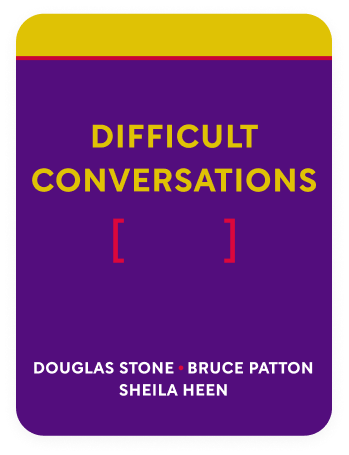

This article is an excerpt from the Shortform book guide to "Difficult Conversations" by Douglas Stone, Bruce Patton, Sheila Heen. Shortform has the world's best summaries and analyses of books you should be reading.
Like this article? Sign up for a free trial here .
Do you consider yourself a good judge of character? What behavior clues do you pay attention to when trying to read people’s intentions?
We usually read people’s intentions based on the impact they had on us. But how we respond to something is not sufficient evidence to draw conclusions about someone else’s intentions.
Here is why you shouldn’t try to read people’s intentions based solely on your own reaction.
How to Read People’s Intentions: The Traps to Avoid
We all know our own intentions, so we never question them. But we never know the other person’s intentions unless we ask — and we rarely do that in the midst of a conversation. Instead, we try to read people’s intentions based of the impact they had on us. This often leads to unfounded assumptions. We assume that cutting remark was meant to hurt us, even though we know our own remark that seemed to hurt the other person’s feelings wasn’t meant to hurt them.
Intentions influence how we view other people: we judge someone more harshly if we think they intended to hurt us, or if we think their intentions are bad or ignoble.
Think of it this way: you’re in a rush to get back to the office after stopping off at a cafe to get a quick bite for lunch. You go to back out of your parking spot, but you find yourself blocked in by a fancy BMW, parked in the middle of the lot. What’s the first thought that jumps into your mind? Now, what if it was an ambulance with its lights on instead? This is a good metaphor for how we go into difficult conversations. The BMW represents the assumption that someone has bad intentions; the ambulance represents the assumption that something else important might be going on.
Don’t Rely on Your Feelings
We can never know someone else’s intentions — when we try to read people’s intentions based solely on nonverbal cues, we’re usually wrong. We usually read people’s intentions based off the impact it had on us. It’s a retroactive reframing of how they intended something. Their comment hurt us, so they must have said it with the intention to hurt us. How we respond to something is not sufficient evidence to draw conclusions about someone else’s intentions.
We usually assume bad intentions so quickly that we don’t realize it’s an assumption — we think it’s a fact. Email and text-based communication can make it harder to assume the best about other people, because it’s harder to pick up on the tone of things and easier to fill in the gaps ourselves.
Furthermore, we usually assume the worst about other people, though we want them to assume the best about us. When we make a comment that hurts someone else’s feelings, we didn’t mean to be hurtful — we had other reasons for saying it. But when someone else hurts our feelings, their only intention could have been to hurt us. We give ourselves a lot of leeway that we don’t give other people. This is partially because we know everything that’s going on in our minds but less about how our actions or words are impacting other people.
- For example, if your colleague questions your reasoning in a meeting, you assume it’s because they’re trying to embarrass you in front of the boss — but if you question your colleague’s reasoning in a meeting, you know it’s because you’re trying to be helpful.
Then, when we accuse someone of having bad intentions, they understandably get defensive. They make the same assumption about us that we’ve made about them — that we’ve accused them because we want them to hurt or feel bad. In difficult conversations, often both people think they’re the victim who was just defending themselves against the bad intentions of the other person. And these assumptions can become self-fulfilling prophecies.
- For example, your boss denies you the lead on a big project. You assume this means she thinks you’re bad at your job and not ready for a leadership role. Because you think this, you start to get annoyed when she asks you to do something, and take an attitude with her based on your assumption of her opinion of you. But then, she starts to assume you’re misbehaving for no reason, which leads her to believe that you’re not ready for a leadership role, which takes us back to square one.
Don’t Assume, Clarify
Good intentions aren’t a free pass for hurting someone’s feelings. Difficult conversations can even devolve into an argument over intentions — “I said I didn’t mean to hurt your feelings when I laughed, okay? So why are you still upset?”
Usually, when someone says we meant to hurt them, what they’re really saying is we didn’t care enough not to hurt them.
- A father says he’ll make it to his son’s basketball game, but then a last-minute project comes up at work and he has to miss it. He didn’t intend to hurt his son by missing the basketball game — but work was ultimately more important to the father than his son’s basketball game. This is what the son feels hurt about.
Clarifying your intentions can be helpful, but it’s important to do it at the right time. If you start a conversation by clarifying intentions, it’s a surefire sign that you haven’t understood what really hurt the person or what they’re trying to say.
True people’s intentions are usually more complex than plain good or plain bad. We want to believe that our intentions are totally good, but usually, if we’re honest with ourselves, intentions are a mixed bag — some good, some bad.
- For example, a wife asks her husband to help her stop mindlessly eating. At a party with some friends, he snaps at her to lay off the cheese and crackers. Of course, it’s probably part of his intentions to help his wife do the thing she wants to do, to be supportive of her — good intentions. But he might also be annoyed that he has to remind her when it’s something she wants to do, or embarrassed that he has to say something in front of their friends — these feelings might lead to the unconscious intention to embarrass his wife. His intentions are neither purely good nor purely bad.
- Sometimes our intentions genuinely don’t involve the other person at all: “I’m tired, so I don’t feel like talking, even if you need to right now.”
- Sometimes we have good intentions — and we still end up hurting someone.
We aren’t always aware of our own motivation, so we need to explore and be willing to entertain the idea that our intentions might not be as good as we think they are. Defending our “good” intentions suggests we’re more interested in our own feelings than what’s going on in the relationship. “I didn’t mean to, so why are you upset?” The subtext here is “I don’t want to feel bad about hurting your feelings, so stop making me feel bad, no matter what you feel.”
Conversely, people who show they can think hard about their own intentions also show they care about the relationship.

———End of Preview———
Like what you just read? Read the rest of the world's best book summary and analysis of Douglas Stone, Bruce Patton, Sheila Heen's "Difficult Conversations" at Shortform .
Here's what you'll find in our full Difficult Conversations summary :
- Why healthy relationships need difficult conversations
- The 3 conversations that happen within each difficult conversation
- How difficult conversations go wrong and what to do about it






